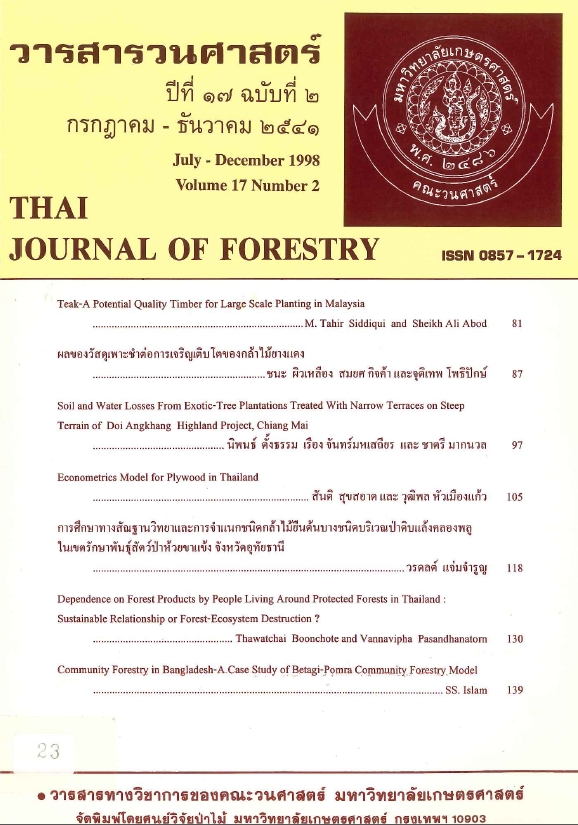ECONOMETRICS MODEL FOR PLYWOOD IN THAILAND
Main Article Content
บทคัดย่อ
การศึกษาครั้งนี้มีวัตถุประสงค์เพื่อสร้างแบบจำลอง อุปสงค์ อุปทาน และราคาของไม้อัด ตลอดจนหาค่าความยืดหยุ่นของอุปสงค์ และอุปทานที่เกิดจากตัวแปรอิสระแต่ละตัวที่อยู่ในแต่ละฟังก์ชั่น และคาดคะเนแนวโน้มของอุปสงค์ อุปทานและราคาของไม้อัดในอนาคตของประเทศไทย ในการหาค่าสัมประสิทธิ์การถดถอยของโมเดลดังกล่าว ใช้วิธี Two stage least squares จากการศึกษาพบว่าตัวแปรที่มีผลต่ออุปสงค์ของไม้อัดคือราคาขายส่งเฉลี่ยของไม้อัดและราคาขายส่งเฉลี่ยของปูนซีเมนต์ผสม ตัวแปรที่มีผลต่ออุปทานของไม้อัดคือราคาขายส่งเฉลี่ยของไม้อัดในปีที่ผ่านมาและปริมาณนำเข้าไม้ท่อน และตัวแปรที่มีผลต่อราคาขายส่งเฉลี่ยของไม้อัดคือรายได้เฉลี่ยต่อคนและปริมาณความแตกต่างระหว่างอุปทานและอุปสงค์ในปีที่ผ่านมา ค่าสัมประสิทธิ์การตัดสินใจของอุปสงค์ อุปทานและราคาขายส่งเฉลี่ยของไม้อัดมีค่าเท่ากับ 0.848 0.809 และ 0.954 ตามลำดับ ค่าความยืดหยุ่นของอุปสงค์ อุปทานของไม้อัดที่เกิดจากการเปลี่ยนแปลงของราคามีค่าเท่ากับ 0.1713 และ 0.6404 ตามลำดับ จากการคาดคะเนแนวโน้มของอุปสงค์ อุปทานและราคาของไม้อัดในช่วงปี 2541 - 2450 พบว่ามีอัตราการเพิ่มขึ้นโดยเฉลี่ยเท่ากับ 11.32, 9.64 และ 5.89 เปอร์เซ็นต์ ตามลำดับ
Downloads
Article Details

อนุญาตภายใต้เงื่อนไข Creative Commons Attribution-NonCommercial-NoDerivatives 4.0 International License.
ข้าพเจ้าและผู้เขียนร่วม (ถ้ามี) ขอรับรองว่า ต้นฉบับที่เสนอมานี้ยังไม่เคยได้รับการตีพิมพ์และไม่ได้อยู่ในระหว่างกระบวนการพิจารณาตีพิมพ์ลงในวารสารหรือสิ่งตีพิมพ์อื่นใด ข้าพเจ้าและผู้เขียนร่วม (ถ้ามี) ยอมรับหลักเกณฑ์และเงื่อนไขการพิจารณาต้นฉบับ ทั้งยินยอมให้กองบรรณาธิการมีสิทธิ์พิจารณาและตรวจแก้ต้นฉบับได้ตามที่เห็นสมควร พร้อมนี้ขอมอบลิขสิทธิ์ผลงานที่ได้รับการตีพิมพ์ให้แก่วารสารวนศาสตร์ คณะวนศาสตร์ มหาวิทยาลัยเกษตรศาสตร์ กรณีมีการฟ้องร้องเรื่องการละเมิดลิขสิทธิ์เกี่ยวกับภาพ กราฟ ข้อความส่วนใดส่วนหนึ่ง หรือ ข้อคิดเห็นที่ปรากฏในผลงาน ให้เป็นความรับผิดชอบของข้าพเจ้าและผู้เขียนร่วม (ถ้ามี) แต่เพียงฝ่ายเดียว และหากข้าพเจ้าและผู้เขียนร่วม (ถ้ามี) ประสงค์ถอนบทความในระหว่างกระบวนการพิจารณาของทางวารสาร ข้าพเจ้าและผู้เขียนร่วม (ถ้ามี) ยินดีรับผิดชอบค่าใช้จ่ายทั้งหมดที่เกิดขึ้นในกระบวนการพิจารณาบทความนั้น”


